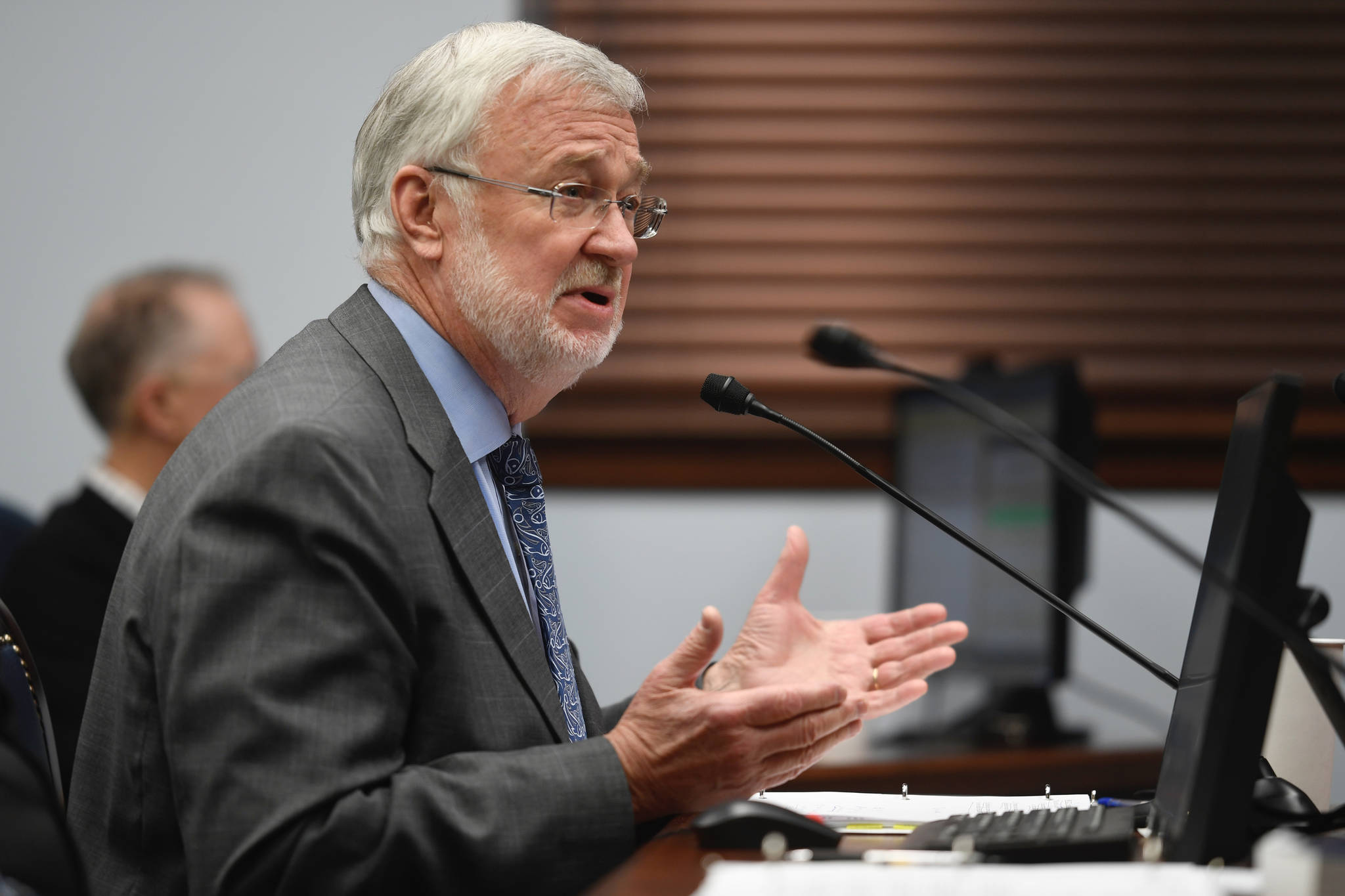With the Alaska Legislature now in session more than 45 days, the big issue remains the Procrustean budget proposed by Gov. Mike Dunleavy. On a visit last Friday to the lower Kenai Peninsula, Sen. Gary Stevens (R-Kodiak) stopped by the Homer News for an interview and spoke of the Alaska Senate’s attention to Dunleavy’s fiscal approach.
“That’s the most important thing happening,” Stevens said. “Really, the key is the budget. Everyone is focused on that.”
A citizen initiative imposed a 90-day limit on the legislative session, but the Legislature abides by the 121-day constitutional limit. Stevens said he doesn’t think the Legislature will finish by 90 days.
“Getting the House and Senate in agreement is not going to happen real fast,” Stevens said. “You don’t want it to be fast; you want it thoughtful and well done.”
Stevens said an online poll and constituent mail has shown strong opposition to Dunleavy’s budget and his extreme cuts, like shutting down winter service to the Alaska Marine Highway system, and drastic cuts to primary, secondary and university education funding. Some support Dunleavy’s proposal to fully fund Alaska Permanent Fund Dividends, according to the traditional formula, he said.
“I hear ‘I want that dividend no matter what. I earned it,’” Stevens said. “… That’s a minority. Ninety percent are saying, ‘If you have to have it (use the PFD) to keep our society alive, do that.’”
As the Legislature grapples with the budget, it’s looking at options, Stevens said. One option is a reduced dividend.
“We have a $1.6 billion deficit,” he said. “If we were to have a $400 dividend, we would have no deficit. There are solutions out there. I’m not proposing a $400 dividend. We need to cut the budget.”
However, a low dividend brings more hammers, measuring tapes and saws to the fiscal toolbox.
“If a $400 dividend would balance the budget, you have to think it’s a balancing act,” he said. “…How do you do a reasonable thing, something folks can say, ‘That makes sense to me?’”
But Stevens also said he supports reasonable budget cuts and cost-saving measures, like maybe reducing ferry voyages to get higher usage.
“There’s an area we can see some reasonable cuts rather than close it down,” he said.
Stevens said he thinks the dividend will end up being closer to $1,000-$1,600 by reducing the budget somewhat instead of approving the governor’s budget.
“It’s devastating,” he said of Dunleavy’s approach.
Stevens said he and other legislators have been frustrated by Dunleavy not considering the economic impacts of his budget.
“What we have found are the proposals the governor has made … often haven’t been thought out. They haven’t considered the impact,” he said.
Stevens is on the Senate Finance Committee.
The question was asked in committee about what would happen to school districts if the $100 million spent to help pay for bonds was cut, as Dunleavy proposes.
“It wasn’t really very well thought out. What happens on the impact on our community?” Stevens said.
He said budget director Donna Arduin’s response was, “‘That’s not my problem.’ That seems shallow to me and not realize you’re passing that $100 million debt to the communities.”
Similarly, taking away the portion of fish landing taxes and oil and gas property taxes that currently goes to municipalities would have an impact on the Kenai Peninsula and on fishing communities. Stevens said one Dutch Harbor council member told him the loss of fish landing taxes would result in a four-times increase to the local mill rate.
When asked if taking away those tax revenues at the local level went against Dunleavy’s campaign promise not to raise taxes, Stevens said, “You’re right. I think that’s a very good point. The governor said no to taxes, but there will be if that budget goes through — local taxes, not state taxes.”
Dunleavy’s budget would have an enormous impact on the economy, with 5,000 real, direct jobs lost, Stevens said. That’s not counting the indirect jobs that would also be lost because of things like laid-off workers who would no longer be pumping money into the economy. Stevens said economists have presented figures of an additional 10,000 indirect jobs being lost if the budget goes through unchanged.
“It’s an impact on every community in our state,” he said.
Stevens said an idea proposed by Senators Natasha von Imhof and Bert Stedman of a 3-year ramp down of a reduced budget is being considered.
“We need to think about how we can make it easier,” Stevens said. “Absolutely. This cold turkey, taking $1.6 billion out of the budget is just virtually impossible. I don’t see it happening. I don’t see the legislature supporting that.”
In past years, sometimes the governor and the House or the governor and the Senate would be against another legislative branch.
“I’ve never seen it so the House and the Senate are so aligned against the governor,” Stevens said.
However, the governor has a tool he can wield: the line-item veto. If the Legislature puts budget items back in, Dunleavy can veto them.
“I’ve worked with the governor… He’s pretty stubborn,” Stevens said.
The Legislature also has power, though, especially when it comes to add the PFDs Dunleavy promised voters.
“The PFD is the key,”Stevens said. “The governor has enormous power in this state … he can line-item veto. He can take money out of the budget in any of those places.”
“What he can’t do is add money,” Stevens continued. “I think that’s the key on the PFD. If we were to put in a $1,600 PFD, he can’t veto that. He could veto the entire budget.”
The next step in the budget debate is coming to agreement between the House and the Senate.
“Once we know how the House and Senate line up, we can negotiate with him (Dunleavy),” Stevens said. “I hope we can negotiate with him.”
Reach Michael Armstrong at marmstrong@homernews.com.


